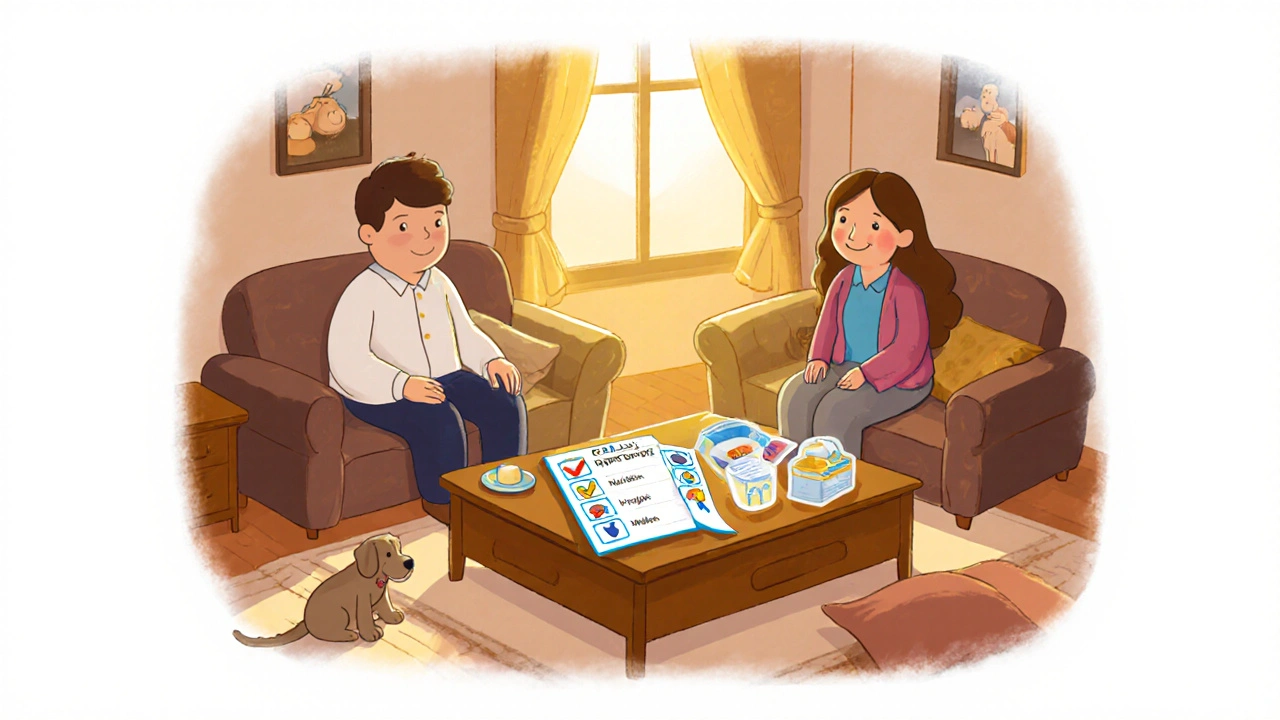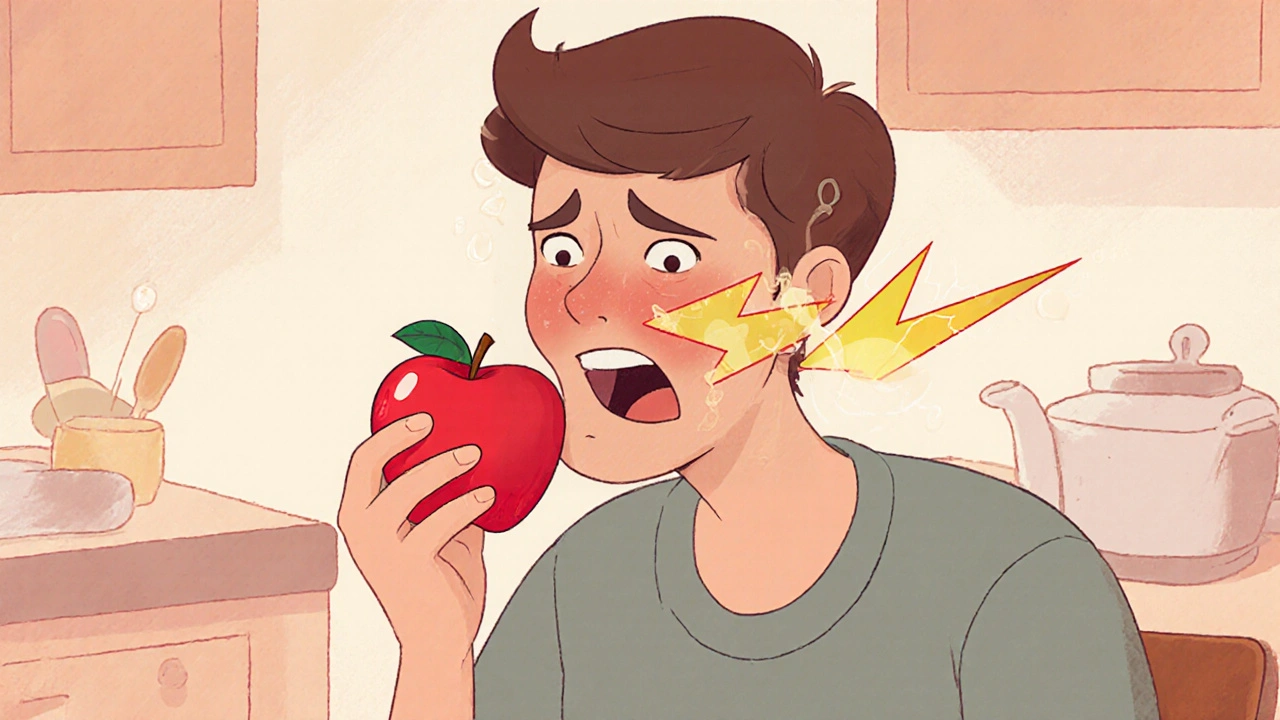TN Symptom & Trigger Tracker
Daily Symptom Log
Your Insights
Log your symptoms to see personalized patterns and advice.
Tip: Consistent logging helps identify your unique triggers. Share your insights with your healthcare team to optimize treatment.
When a sudden, electric‑shock‑like pain hits one side of the face, it can feel like the world has stopped for a moment. Trigeminal Neuralgia is a chronic neurological disorder that unleashes brief but excruciating attacks of facial pain, often triggered by ordinary activities such as chewing, speaking, or even a gentle breeze. If you’re battling trigeminal neuralgia, the condition quickly moves beyond the physical sensation and seeps into every corner of daily life and mental health.
Key Takeaways
- Trigeminal Neuralgia (TN) causes sharp facial pain that disrupts basic tasks like eating and grooming.
- Persistent pain is closely linked to depression, anxiety, and sleep disturbances.
- Medication, minimally invasive surgery, and lifestyle tweaks together offer the best chance at relief.
- Mental‑health support-CBT, support groups, and stress‑reduction techniques-helps prevent the spiral into chronic distress.
- A simple daily checklist can keep treatment, mood, and quality‑of‑life goals on track.
What Exactly Is Trigeminal Neuralgia?
In medical terms, Trigeminal Neuralgia is a neuropathic condition affecting the trigeminal nerve, the fifth cranial nerve responsible for facial sensation and chewing movements. The most common cause is Neurovascular Compression where a blood vessel presses against the nerve root, irritating its sheath and triggering erratic firing. Less frequently, tumors, multiple sclerosis plaques, or surgically induced scar tissue can be the culprits.
How TN Disrupts Everyday Activities
Imagine trying to bite into an apple, only to feel a bolt of pain that forces you to drop the fruit. For many living with TN, that scenario repeats with every bite, every sip, even every brushstroke while shaving. The following daily tasks become high‑stakes:
- Eating and drinking: Tender foods such as noodles or soups often trigger attacks, leading patients to adopt a bland, soft‑food diet that can cause nutritional gaps.
- Speaking and laughing: Conversational pauses become common as people fear the next shock.
- Personal hygiene: Brushing teeth or shaving can feel like walking on a bed of nails, prompting some to skip these routines altogether.
- Driving: Sudden facial pain can distract attention, raising safety concerns for both the driver and passengers.
These limitations erode Quality of Life a multidimensional measure covering physical health, emotional well‑being, social participation, and functional independence. Studies from 2023 show that TN patients report a 45% lower health‑related quality‑of‑life score compared with age‑matched controls.
Mental‑Health Ripple Effects
The relentless cycle of anticipation-"Will the next event trigger pain?"-feeds into chronic stress. This stress spawns two of the most common psychiatric comorbidities:
- Depression characterized by persistent low mood, loss of interest, and fatigue. A 2022 longitudinal survey found that 38% of TN sufferers met clinical criteria for major depressive disorder.
- Anxiety manifesting as excessive worry, panic attacks, and hyper‑vigilance to facial sensations. The same study reported a 42% prevalence of generalized anxiety disorder.
Sleep quality also takes a hit. The pain spikes often occur at night, interrupting REM cycles and leaving patients exhausted, which in turn worsens mood and pain perception-a vicious feedback loop.
Physical Pain Management Options
Because TN pain is neuropathic, the treatment toolbox differs from typical musculoskeletal aches. Below is a quick comparison of the most widely used options.
| Option | Mechanism | Typical Effectiveness | Common Side Effects | Recovery / Downtime |
|---|---|---|---|---|
| Carbamazepine | Blocks sodium channels, dampening nerve firing | 70‑80% achieve significant pain reduction | Drowsiness, dizziness, low sodium | None (oral medication) |
| Oxcarbazepine | Similar to carbamazepine but with fewer blood‑level fluctuations | 60‑70% response rate | Hyponatremia, rash | None |
| Gamma Knife Surgery | Focused radiation lesioning the nerve root | 50‑65% long‑term relief | Facial numbness, rare radiation‑induced changes | Outpatient; few days of mild discomfort |
| Microvascular Decompression (MVD) | Surgical repositioning of offending blood vessel | 80‑90% immediate relief | Infection, hearing loss, cerebrospinal fluid leak | Hospital stay 3‑5days; weeks of recovery |
When medication alone fails or side effects become intolerable, many neurologists recommend moving to a minimally invasive procedure like Gamma Knife before opting for the more invasive MVD. The choice depends on patient age, overall health, and personal preference for risk versus speed of relief.
Supporting Mental Health While Managing Pain
Even the best physical treatment won’t fully restore well‑being if the emotional toll remains unaddressed. Here are three evidence‑based approaches that pair well with medical therapy:
- Cognitive Behavioral Therapy (CBT) a structured, goal‑oriented therapy that helps reframe pain‑related thoughts and develop coping strategies. Randomized trials in 2021 showed a 30% reduction in depression scores for TN patients who attended weekly CBT sessions for three months.
- Join a Support Group where peers share experiences, tips, and emotional encouragement. The sense of belonging reduces isolation and provides practical advice on managing meals, dental care, and medication side effects.
- Integrate stress‑reduction techniques such as mindfulness meditation, diaphragmatic breathing, or gentle yoga. A 2022 pilot study reported that daily 10‑minute mindfulness reduced pain intensity by an average of 1.5 points on a 10‑point scale.

Practical Daily Checklist for Living with TN
Turning advice into habit is easier when you have a concrete checklist. Print it out and keep it on your nightstand or fridge.
- Morning medication: Verify dose, timing, and any side‑effects.
- Nutrition: Choose soft‑texture foods for breakfast; add a multivitamin if diet is limited.
- Trigger log: Note any activity that caused a pain burst (e.g., brushing teeth, phone call).
- Exercise: 15‑minute walk or stretching, avoiding sudden facial movements.
- Mindfulness: 5‑minute breathing exercise before lunch.
- Social check‑in: Call a friend or attend an online support group meeting.
- Evening review: Rate pain, mood, and sleep quality; adjust next day’s plan.
Review the checklist with your neurologist or pain specialist every quarter. Small adjustments-like swapping a medication or adding a new coping skill-can make a huge difference over time.
When to Seek Professional Help
Not all facial pains are TN, and not every TN episode requires emergency care. However, watch for these red flags:
- Sudden loss of facial muscle control (possible stroke warning).
- Uncontrolled hypertension or severe dizziness after a pain attack.
- Side effects from medication that interfere with daily function (e.g., extreme drowsiness).
- Persistent low mood, thoughts of self‑harm, or inability to enjoy previously loved activities.
In any of these cases, contact your healthcare provider promptly. Early intervention can prevent complications and preserve both physical and mental health.
Frequently Asked Questions
What triggers a Trigeminal Neuralgia attack?
Common triggers include chewing, speaking, brushing teeth, shaving, wind, and even light touch on the face. Some people also notice attacks after stress or sudden temperature changes.
Can lifestyle changes reduce the frequency of attacks?
Yes. Maintaining a soft‑food diet, practicing gentle facial movements, managing stress through mindfulness, and keeping a trigger diary can all lower attack frequency for many patients.
Is medication the only treatment option?
Medication is often the first line, but surgical options like Gamma Knife radiosurgery or microvascular decompression provide long‑term relief for those who don’t respond to drugs or who experience intolerable side effects.
How does Trigeminal Neuralgia affect mental health?
The unpredictable pain spikes lead to chronic stress, which raises the risk of depression and anxiety. Sleep disruption further amplifies mood disturbances, creating a feedback loop that worsens both pain perception and emotional well‑being.
What support resources are available for TN patients?
National neuropathic pain societies, online forums, local support groups, and mental‑health services offering CBT are all valuable. Many hospitals also have pain‑management clinics that combine medical and psychological care.


I totally get how unpredictable those shock‑like attacks can ruin everyday moments. The key is to build a routine that puts you a little bit in control – same time for meds, a trigger diary, and gentle stretching that avoids sudden facial movements. Try scheduling a short mindfulness break right after lunch; even five minutes of focused breathing can lower the stress hormones that amplify pain. Keep your dentist in the loop, too – they can suggest a softer brushing technique that reduces the jolt. Remember, you’re not alone in this, and each small habit you nail down builds a bigger safety net for your mental health.
You think the pharma companies are just giving you pills, but actually they’re using TN patients to test the next wave of neural chips. Every “new procedure” they hype up is a cover for data mining your facial reactions. The real cure is hidden by the “big pharma” agenda that wants you dependent forever. It’s no coincidence that the support groups are sponsored by the same corporations that profit from your misery. Stay skeptical and keep a paper trail of every treatment they push on you.